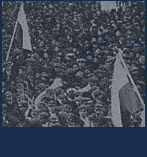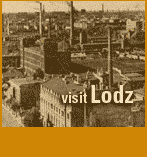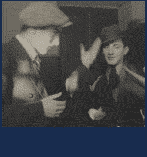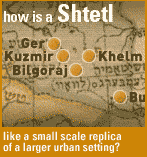

Yiddish Theater
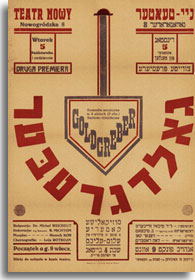

Jews in Eastern Europe began to put on improvised folk plays for the holiday of Purim ![]() as early as the Middle Ages, taking advantage of the holiday's built-in emphasis on costumes, celebration, and play-acting. In many communities, these plays evolved into elaborate folk theater productions with musical scores performed by singers and klezmer musicians. Then in the late 19th century, modern Yiddish theater began to emerge in Yiddish-speaking communities - from small towns in Romania to big cities like London, St. Petersburg, and New York. Music became a central part of this new theater, as playwrights and composers created fresh styles of popular songs and light operettas, borrowing liberally from all the other traditional kinds of Jewish music. The earliest plays, however, were performed as traveling street and cabaret theater, frequently without instrumental accompaniment.
as early as the Middle Ages, taking advantage of the holiday's built-in emphasis on costumes, celebration, and play-acting. In many communities, these plays evolved into elaborate folk theater productions with musical scores performed by singers and klezmer musicians. Then in the late 19th century, modern Yiddish theater began to emerge in Yiddish-speaking communities - from small towns in Romania to big cities like London, St. Petersburg, and New York. Music became a central part of this new theater, as playwrights and composers created fresh styles of popular songs and light operettas, borrowing liberally from all the other traditional kinds of Jewish music. The earliest plays, however, were performed as traveling street and cabaret theater, frequently without instrumental accompaniment.
Soon the Yiddish theater began to use pit orchestras of musicians, often recruited from the ranks of klezmer musicians, to perform long scores complete with overtures and solos. In the 1910s and 1920s, Yiddish theater flourished and became a huge musical industry in cities such as New York and Warsaw. Oddly enough, in its early years, the Soviet Union actually sponsored an official state Yiddish theater; this cultural experiment ended disastrously under Stalin's  brutal repression of Jewish culture. Today it is still possible to regularly see Yiddish theater performed in New York, and Montreal, and occasionally elsewhere.
brutal repression of Jewish culture. Today it is still possible to regularly see Yiddish theater performed in New York, and Montreal, and occasionally elsewhere.
Russian Jewish Classical Music
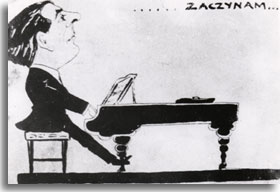

As nationalism began to rise in late 19th-century Eastern Europe, many classical musicians across the region responded by turning to their people's folk culture as a source of artistic inspiration and material for their own compositions. A similar movement also began among Jewish classical musicians in Tsarist Russia, as young composers who had been classically trained in European conservatories began to focus their attention and efforts on Jewish music ![]() . By 1908, the St. Petersburg Society for Jewish Folk Music, a new musical organization, had been established in Russia. This society sponsored research to collect traditional Jewish music for scholarly study, popular education, and as the basis for building a modern Jewish style of classical music. Using elements from the full range of Jewish music - from Yiddish folk songs to Hebrew synagogal chants, to Hasidic nigunim, to klezmer dance tunes - these composers wrote chamber music, symphony concertos, and even operas
. By 1908, the St. Petersburg Society for Jewish Folk Music, a new musical organization, had been established in Russia. This society sponsored research to collect traditional Jewish music for scholarly study, popular education, and as the basis for building a modern Jewish style of classical music. Using elements from the full range of Jewish music - from Yiddish folk songs to Hebrew synagogal chants, to Hasidic nigunim, to klezmer dance tunes - these composers wrote chamber music, symphony concertos, and even operas ![]() . Although the society formally disbanded just 10 years later during the chaos of the Russian Revolution, the music created as well as its individual members have both proven to have a huge influence throughout the Jewish and general classical music worlds, especially in the former Soviet Union, Europe, Israel, and the United States.
. Although the society formally disbanded just 10 years later during the chaos of the Russian Revolution, the music created as well as its individual members have both proven to have a huge influence throughout the Jewish and general classical music worlds, especially in the former Soviet Union, Europe, Israel, and the United States.







